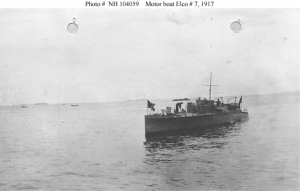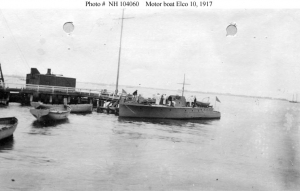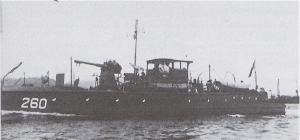Lists of Particulars
There are various, sometimes conflicting sources of information for the particulars we have regarding the Motor Launch in its various guises. Given its publication by the producer of the power plants used by Elco in the ML's, along with the authority of its author William Washburn Nutting, I am inclined to take the design particulars presented in The Cinderellas of the Fleet as the closest thing to gospel that exists. Details available in Jane's Fighting Ships 1919 are similar though not exactly the same. Jane's has the added detail of listing three "series" of boats produced by Elco which Nutting doesn't explicitly mention. This is noted in other sources as well. In any event, the design particulars presented here are drawn from these sources as well as accounts in various other books.
It is also clear that a number of ML's were delivered to the French and Italian navies and perhaps even to the Russian navy. Dittmar & Colledge (British Warships 1914-1919) give the specific ML numbers delivered to the French navy. Four are noted by Sanford Terry in his Zeebrugge and Ostend Dispatches, Etc. (French ML's 1, 2, 33, and 34) as having taken part in the raids on Zeebrugge and Ostend. Additionally, Jane's Fighting Ships 1919 notes the existence of two types of ML's (known to the French as Vedettes)—one sort of which clearly fits the Elco description. This group encompasses V.62–V.73 (eleven boats). These numbers clearly don't match Dittmar & College's or Sanford Terry's lists and it is entirely possible that the French ML's that participated in these raids were not of the Elco design. Alternatively, Jane's may simply be incorrect in their numbering of the French ML's/Vedettes.
In regards to the Italian navy, the MAS (Motobarcha Armata SVAN) was a popular style of small motor-boat. There were a number of different types employed in duties similar to those of the British CMB's and ML's. Jane's Fighting Ships 1919 notes that the MAS Type C had the same appearance as the British ML's 1–151 (I'm not sure how that category was arrived at). Jane's notes that 127 of these were built by Elco between 1916 and 1919 for the Italian navy and, as of 1919 an additional 35 were under construction. All particulars given coincide fairly well with what one would expect of an Elco Motor Launch. However, Conway's All The World's Fighting Ships 1906-1921 proves what may be a better source in regards to the Italian navy. More detail is provided on the delivery dates of 105 ML's between 1917 (the first batch of 43 in 1917, the second batch of 12 in 1917–1918, and the final batch of 50 in 1918) and late 1918. Details regarding armament, vessel numbering, and the fates of various ML's is provided so I believe Conway's to be a bit better researched in this particular arena than Jane's.
There are various, sometimes conflicting sources of information for the particulars we have regarding the Motor Launch in its various guises. Given its publication by the producer of the power plants used by Elco in the ML's, along with the authority of its author William Washburn Nutting, I am inclined to take the design particulars presented in The Cinderellas of the Fleet as the closest thing to gospel that exists. Details available in Jane's Fighting Ships 1919 are similar though not exactly the same. Jane's has the added detail of listing three "series" of boats produced by Elco which Nutting doesn't explicitly mention. This is noted in other sources as well. In any event, the design particulars presented here are drawn from these sources as well as accounts in various other books.
It is also clear that a number of ML's were delivered to the French and Italian navies and perhaps even to the Russian navy. Dittmar & Colledge (British Warships 1914-1919) give the specific ML numbers delivered to the French navy. Four are noted by Sanford Terry in his Zeebrugge and Ostend Dispatches, Etc. (French ML's 1, 2, 33, and 34) as having taken part in the raids on Zeebrugge and Ostend. Additionally, Jane's Fighting Ships 1919 notes the existence of two types of ML's (known to the French as Vedettes)—one sort of which clearly fits the Elco description. This group encompasses V.62–V.73 (eleven boats). These numbers clearly don't match Dittmar & College's or Sanford Terry's lists and it is entirely possible that the French ML's that participated in these raids were not of the Elco design. Alternatively, Jane's may simply be incorrect in their numbering of the French ML's/Vedettes.
In regards to the Italian navy, the MAS (Motobarcha Armata SVAN) was a popular style of small motor-boat. There were a number of different types employed in duties similar to those of the British CMB's and ML's. Jane's Fighting Ships 1919 notes that the MAS Type C had the same appearance as the British ML's 1–151 (I'm not sure how that category was arrived at). Jane's notes that 127 of these were built by Elco between 1916 and 1919 for the Italian navy and, as of 1919 an additional 35 were under construction. All particulars given coincide fairly well with what one would expect of an Elco Motor Launch. However, Conway's All The World's Fighting Ships 1906-1921 proves what may be a better source in regards to the Italian navy. More detail is provided on the delivery dates of 105 ML's between 1917 (the first batch of 43 in 1917, the second batch of 12 in 1917–1918, and the final batch of 50 in 1918) and late 1918. Details regarding armament, vessel numbering, and the fates of various ML's is provided so I believe Conway's to be a bit better researched in this particular arena than Jane's.
The Naval Historical Center has two photographic records of Elco ML's that are noted as having been built for the Italian navy to be designated as MAS-77 and MAS-78. These two ships, probably launched in April, 1917, were appropriated by the US Navy for a period of time and were designated Elco 7 and Elco 10. They were turned over to the Italian navy in December of 1917, entering active service by June of 1918. It is not clear if either ship was armed with a foredeck gun while in service with the US Navy.

Elco 7 |

Elco 10 |
It is also interesting to note a particular modified ML type in Conway's—clearly based on the Elco ML design but constructed in Italy and 14' shorter on the waterline than the standard ML. These were apparently known as the "May, 1917" type ML and were armed and powered much the same as the standard ML but appear to have not had the usual chart-house cabin.
As to the Russian navy Jane's Fighting Ships 1919 simply notes an unknown number of motor patrol boats of varying types stationed in the Baltic, White, and Black Seas built chiefly by U.S. firms between 1915 and 1916. So it is possible that some Elco Motor Launches made their way into Russian hands.
The Particulars from The Cinderellas of the Fleet
THE ML's IN TABULAR FORM
(Number Built for Allied Nations, 720)
DIMENSIONS
CONSTRUCTION
The Particulars from Jane's Fighting Ships 1919
Note that these refer to the ML's of the Royal Navy
First type: 50 originally built: ML 1–50. Built (and delivered according to Sutphen) 1915.
Second type, 500 originally built: ML 51–550. Built 1915 (1915 and 1916 according to Sutphen - with the first being delivered after the winter freeze in early 1916).
Third type, 30 originally built: ML 551–580. Built 1918 (or possibly late 1917). No details known, but similar to first and second types.
Other Notes
Here are additional details from Jane's Fighting Ships for 1919 that pertain to the ML's of the French Navy
V.62–V.73: (built in Canada 1917–18)
As to the Russian navy Jane's Fighting Ships 1919 simply notes an unknown number of motor patrol boats of varying types stationed in the Baltic, White, and Black Seas built chiefly by U.S. firms between 1915 and 1916. So it is possible that some Elco Motor Launches made their way into Russian hands.
The Particulars from The Cinderellas of the Fleet
THE ML's IN TABULAR FORM
(Number Built for Allied Nations, 720)
DIMENSIONS
- Length over all: 79 ft. 7 in.
- Length on the water line: 78 ft. 9 in.
- Extreme beam over guards: 12 ft. S in.
- Beam on deck: 12 ft. 1 in.
- Draught to bottom of deadwood: 3 ft. 1 in.
- Full load displacement: 78,000 lb.
CONSTRUCTION
- Planking; yellow pine, 19/8 in. thick.
- Frames; white oak, steam bent, 194 in. sided by 13/4 in. molded, spaced 12 in. center to center.
- Heavy frames at bulkheads, 29/ in. by 29/ in.
- Deck planking; Oregon pine in strips, 294 in. wide by 19/ in. thick.
- Deck beams; white oak, sided 13/4 in., molded 29/ in.
- Keel; white oak, sided 4 in.
- Keelson; yellow pine, 4 in. by 5 in.
- Floors; galvanized wrought iron, 19/ in. wide, 9/4 in. thick at center, tapered to 94 in. at ends.
- Knees connecting frames to beams; wrought, 3 in. by ~/8 in.
- Upper clamp; yellow pine, 13/4 in. by 49/2 in.
- Main clamp; yellow pine, 194 by 49/ in.
- Main clamp; yellow pine, 19/ by 59/ in.
- Hogging clamp; yellow pine, 19/ in. by 59/ in.
- Side keelson; yellow pine, 13/4 in. by 69/ in.
- Bilge stringer; yellow pine, 19/ in. by 49/ in.
- Bulkheads; six steel, about 9/ in. thick, located at frames Nos. 6, 26, 40, 47, 52 and 71.
The Particulars from Jane's Fighting Ships 1919
Note that these refer to the ML's of the Royal Navy
First type: 50 originally built: ML 1–50. Built (and delivered according to Sutphen) 1915.
- 34 tons.
- Dimensions : 75 x 12 x 3.75 feet.
- Guns: 1–3 pdr. or 2 pdr. AA. and/or 1 or 2 M.G. or Lewis guns.
- Machinery: 2 sets of Standard petrol motors (apparently six cylinder).
- B.H.P. (combined) 440–450 = 19 kts.
- Petrol: about 1650 gallons.
- Complement, 8. (note: Sutphen indicates eight crew and two officers.)
Second type, 500 originally built: ML 51–550. Built 1915 (1915 and 1916 according to Sutphen - with the first being delivered after the winter freeze in early 1916).
- 37 tons.
- Dimensions : 80–88 x 12' 2" x 3' 10".
- Guns : 1–3 inch AA. or lesser calibre of AA. and other types.
- Machinery: 2 sets of Standard petrol motors (apparently six cylinder).
- B.H.P. (combined) 440–450 = 19 kts.
- Petrol: about 1850 gallons.
- Complement, 9. (See note above; Maxwell indicates eight crew and two officers with no regard for type.)
Third type, 30 originally built: ML 551–580. Built 1918 (or possibly late 1917). No details known, but similar to first and second types.
Other Notes
Here are additional details from Jane's Fighting Ships for 1919 that pertain to the ML's of the French Navy
V.62–V.73: (built in Canada 1917–18)
- About 30-35 tons.
- Dimensions : 80-85' x 12-13' x 4-5'. (not very specific are they?)
- Guns : 1–75mm. field gun converted to naval mounting. Two depth charges.
- Machinery: 2 sets petrol motors giving 20–22kts nominal, 19 kts about best maximum at sea for any length of time.
- Radius of action: about 500 miles at full speed and 1000 miles at 12–15kts or less.
- Fuel: about 2000 galls. petrol
- Complent 8-10.
